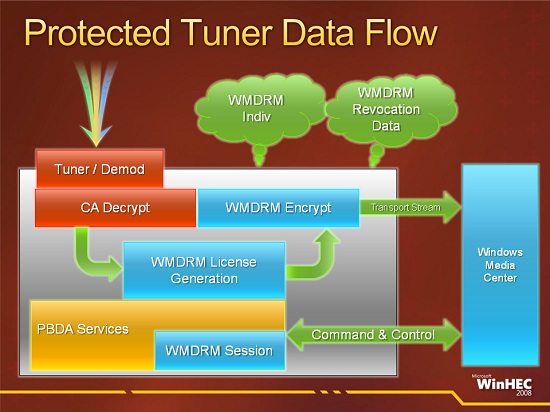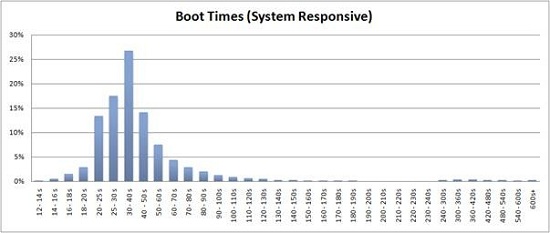Windows 7: Release Candidate 1 Preview
by Ryan Smith and Gary Key on May 5, 2009 11:00 PM EST- Posted in
- Systems
Getting Dirty: What’s Changing Under the Hood
While Windows 7 is a refinement of Vista, this doesn’t preclude making some changes in the kernel and other related systems. Microsoft has opted to spend most of their efforts working on various graphics systems, so among the big changes there’s only a few items of note that don’t fall into the graphics category.
Likely the change with the most immediate impact is that Microsoft has reworked the subsystem responsible for TV tuners, the Broadcast Driver Architecture (BDA). The latest incarnation of BDA adds a full DRM chain, giving rise to the Protected Broadcast Driver Architecture (PBDA). PBDA solves the biggest issue Microsoft has had getting Windows computers accepted as TV viewers: the lack of a simple and effective DRM chain between the tuner and the computer. HDCP ensures that content is protected between the computer and the display, but there has been no standardized way to do the same with incoming content. As such the only services that allow Windows connectivity with protected content thus far have been cable systems using CableCARDs, all the while limiting this functionality to computers specially licensed by CableLabs.

PBDA protected data flow. Slide courtesy Microsoft
PBDA also resolves some lesser technical issues with BDA, such as how a device should communicate with Windows Media Center when it needs setup information that Windows Media Center can’t provide, and how to feed guide data to Windows Media Center (currently it pulls the data from Zap2It). Although this is open to all services, Microsoft’s primary example here is DirecTV, which would require all of these additions. DirecTV has been developing the HDPC-20 tuner for PCs but held it back for unnamed reasons. All indications are that the HDPC-20 will finally be a go due to PBDA (and the addition of H.264 decoding support helps, too).
The downside from all of this however is obvious: more DRM. We’re not fans of DRM, so we’re not enthused to see that yet more DRM is required before content distributors are willing to let Windows computers access their content. It’s very much making a deal with the Devil.
Next up, the Windows kernel has also seen some tweaking in preparation for ever-larger core counts on CPUs. Vista was tuned for up to 32 cores, but the dispatcher lock made scaling beyond that difficult as it causes threads to spend too much time waiting on the lock. The lock has been redesigned to better support more cores, pushing the new cap up to 256 cores. Bear in mind that currently a single Intel Nehalem quad-core processor effectively has eight cores due to Hyper-Threading, so it was possible to hit the 32 core limit on a 4P Nehalem system, directly creating a problem once Intel puts more cores into Nehalem’s successor. With the limit raised to 256 cores, Windows 7 should be well ahead of the CPUs again.
SSD users will be happy to know that Windows 7 has improved support for those devices. Although Windows 7 doesn’t have an SSD-optimized file system as first rumored, it is adding TRIM support. For more details on TRIM, please see our SSD Anthology article
Wrapping up the changes, Microsoft has also added native support for Wireless Wide Area Networks (WWAN), more commonly referred to as mobile broadband networks. Adapters for such networks were already usable on existing Vista and XP installations, but this brings the configuration of those devices into the OS rather than using 3rd party utilities, similar to how Windows took over WiFi management previously.
Further optimizations have also been made under the hood to help contain Windows’ resource usage and speed up its boot time. Microsoft hasn’t documented every single change they’ve made to make Windows less resource hungry, but there’s clearly a cumulative effort beyond just squeezing more out of the DWM and gadgets (more on this later). Meanwhile everything that makes Windows less resource hungry feeds into shaving seconds off how long it takes to boot Windows, which along with other changes is designed to help get Windows to consistently boot in under 30 seconds. Changes here include additional parallelism in driver initialization and chopping down the number of services that load with the system before they’re ever called. SuperFetch has also been slightly tweaked to improve the post-boot experience – it no longer starts caching things immediately after the user account loads, so that using a freshly booted computer isn’t quite so sluggish. In effect SuperFetch has been deprioritized some so that its loading is less noticeable to the user.

Vista SP1 Boot Times, Courtesy Microsoft










121 Comments
View All Comments
Lexington02 - Wednesday, May 6, 2009 - link
He is not late, he is claiming otherwise to the other people who think that Anandtech is MS loving while this dude is claiming to be Apple loving. I wonder, which is true... Apple lovers or Microsoft lovers...Lexington02 - Wednesday, May 6, 2009 - link
He is not late, he is claiming otherwise to the other people who think that Anandtech is MS loving while this dude is claiming to be Apple loving. I wonder, which is true... Apple lovers or Microsoft lovers...Ryan Smith - Thursday, May 7, 2009 - link
From my perspective, if I'm being accused of being an Apple and a Microsoft fanboy in the same article, then I must be doing something right.;-)I'll note that I have a preference for Mac OS X if given a choice, but I'm getting ahead of myself. I'll talk more about that in next week's Ubuntu article.
strikeback03 - Thursday, May 7, 2009 - link
That was my point - I have long stated that 90% of the articles here that compare something generate comments from both sides claiming bias each way. So the anti-Apple comments were late arriving compared to the anti-MS ones.Are we really going to get a Ubuntu article? Is it now on the transition to 9.04 instead of 8.04?
Ryan Smith - Thursday, May 7, 2009 - link
8.04 (because it's the LTS and most comparable to Windows/Mac OS X as such), to be followed up with 9.04.strikeback03 - Thursday, May 7, 2009 - link
Cool. 9.04 finally resolved some out-of-the-box compatibility problems my desktop has had with each release since I started (6.10)Gary Key - Thursday, May 7, 2009 - link
I am still a big fan of DR-DOS. Does that mean I am anti-MS also? :)MichaelD - Wednesday, May 6, 2009 - link
This is important for me as that's what I use for an AV/AM solution. Overall, it looks very impressive, particularly for a RC; it may just get me away from XP.masterbm - Wednesday, May 6, 2009 - link
I have been using windows 7 on my old amd socket 939 4200 4gb ram 8800gs. I started since build 7000. I started out being guy how felt that I was going to stay on vista for most of my machine I will upgrade to windows when it released. My htpc/file server at this time I plan on leaving it at vista. Due to their is no really good way to convert the .wtv format. This htpc box is automated in since it defrag it self scan it self for virus and spyware. Then It just added auto convert of the show that records. I took while to do that stuff not sure if want do every again.(also note htpc is amd 3800)The other thing I will note is that windows 7 becuase it feels snappier has made use that system more then use tofausto412 - Wednesday, May 6, 2009 - link
They need to make the defrag problem able to do more than one drive at a time...or to schedule them out.